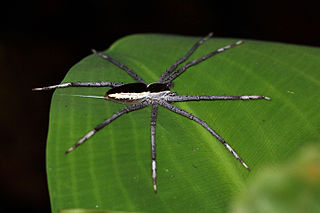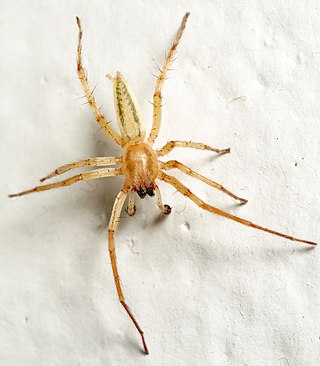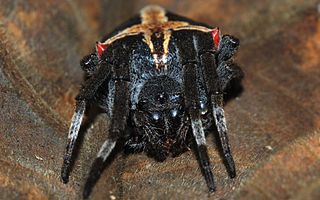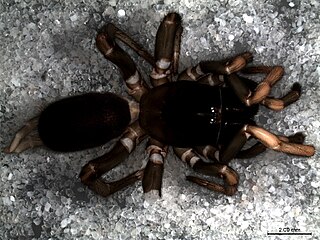
The Thomisidae are a family of spiders, including about 170 genera and over 2,100 species. The common name crab spider is often linked to species in this family, but is also applied loosely to many other families of spiders. Many members of this family are also known as flower spiders or flower crab spiders.

Nursery web spiders (Pisauridae) is a family of araneomorph spiders first described by Eugène Simon in 1890. They resemble wolf spiders (Lycosidae) except for several key differences. Wolf spiders have two very prominent eyes in addition to the other six, while a nursery web spider's eyes are all about the same size. Additionally, female nursery web spiders carry their egg sacs with their jaws and pedipalps instead of attaching them to their spinnerets as wolf spiders do. When the eggs are about to hatch, a female spider builds a nursery "tent", places her egg sac inside, and stands guard outside, hence the family's common name. Like the wolf spiders, however, the nursery web spiders are roaming hunters that don't use webs for catching prey.

Anyphaenidae is a family of araneomorph spiders, sometimes called anyphaenid sac spiders. They are distinguished from the sac spiders of the family Clubionidae and other spiders by having the abdominal spiracle placed one third to one half of the way anterior to the spinnerets toward the epigastric furrow on the underside of the abdomen. In most spiders the spiracle is just anterior to the spinnerets. Like clubionids, anyphaenids have eight eyes arranged in two rows, conical anterior spinnerets and are wandering predators that build silken retreats, or sacs, usually on plant terminals, between leaves, under bark or under rocks. There are more than 600 species in over 50 genera worldwide.

Orb-weaver spiders are members of the spider family Araneidae. They are the most common group of builders of spiral wheel-shaped webs often found in gardens, fields, and forests. The English word "orb" can mean "circular", hence the English name of the group. Araneids have eight similar eyes, hairy or spiny legs, and no stridulating organs.

Theridiosoma is a genus of ray spiders that was first described by Octavius Pickard-Cambridge in 1879. They use their web as a high speed slingshot to actively hunt for prey.

Lyssomanes is a spider genus of the family Salticidae, ranging from South and Central America, up to the southern United States.

Barychelidae, also known as brushed trapdoor spiders, is a spider family with about 300 species in 42 genera.

Parawixia is a genus of orb-weaver spiders first described by F. O. Pickard-Cambridge in 1904. Most species are found in the Neotropics but one species, Parawixia dehaani, is found in Australasia and tropical Asia as far west as India.

Bolostromus is a genus of wafer trapdoor spiders that was first described by Anton Ausserer in 1875.
Cyrtognatha is a genus of long-jawed orb-weavers that was first described by Eugen von Keyserling in 1881. It is a senior synonym of Agriognatha.

Eustala is a genus of orb-weaver spiders first described by Eugène Simon in 1895.

Nilus is a genus of nursery web spiders that was first described by Octavius Pickard-Cambridge in 1876.
Sphecozone is a genus of sheet weavers that was first described by Octavius Pickard-Cambridge in 1871.

Mecaphesa is a genus of crab spiders that was first described by Eugène Louis Simon in 1900.

Arachosia is a genus of anyphaenid sac spiders that was first described by Octavius Pickard-Cambridge in 1882.
Metabus is a genus of long-jawed orb-weavers that was first described by Octavius Pickard-Cambridge in 1899.
Josa is a genus of South American anyphaenid sac spiders first described by Eugen von Keyserling in 1891. It is a senior synonym of "Gayenella", "Haptisus", "Olbophthalmus", and "Pelayo".












